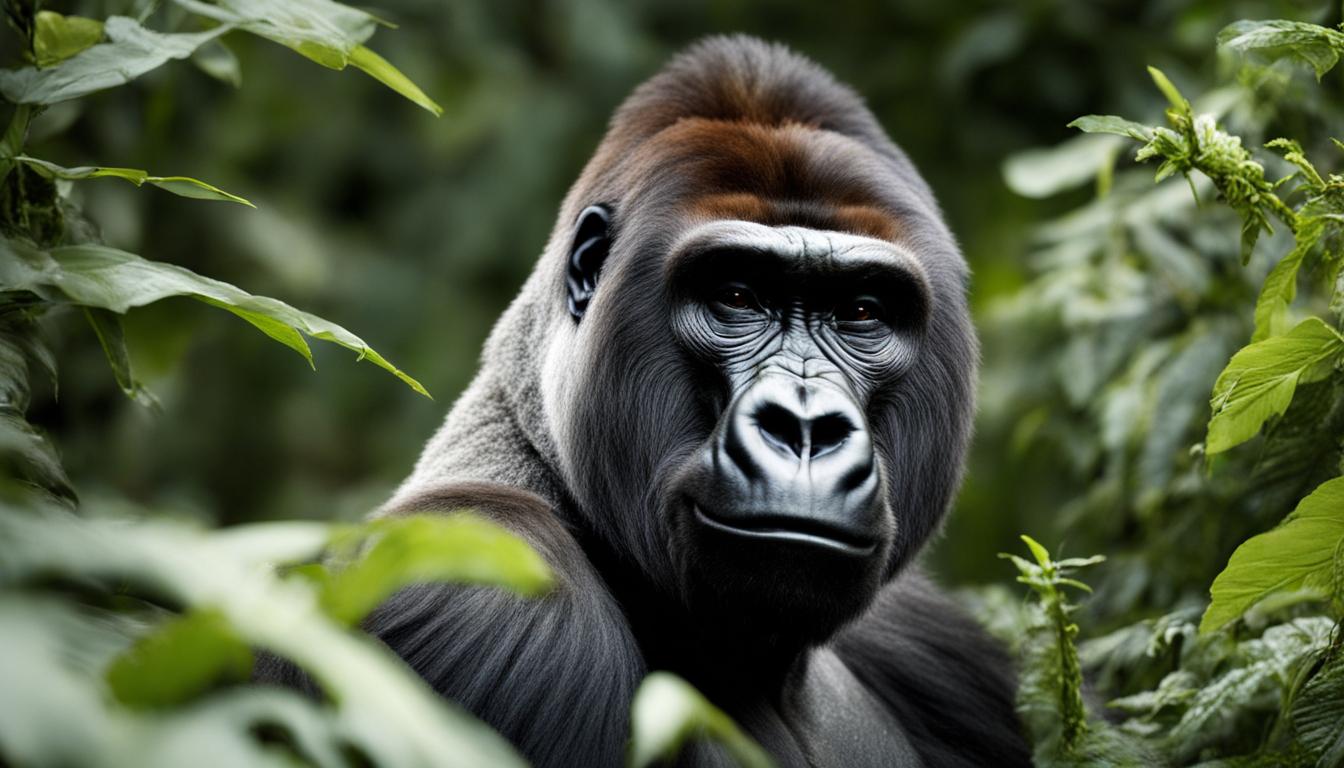Gorillas are fascinating creatures that use a variety of sounds and communication behaviors to interact with each other. From vocalizations to nonverbal cues, their communication repertoire is diverse and complex.
One of the most interesting aspects of gorilla communication is their vocalizations. They have a wide range of vocal sounds, including grunts, grumbles, cough grunts, high-pitched screams, and more. These vocalizations can convey positive emotions, such as the presence of favorite foods, or express displeasure and alarm. Understanding the gorilla vocal repertoire is key to deciphering their messages.
Nonverbal communication also plays a crucial role in gorilla interactions. Visual cues like side-eye glances and postures like chest beating can indicate dominance, aggression, and even playfulness. Gorillas rely on these nonverbal signals to convey their intentions and emotions.
So, if you’ve ever wondered how gorillas communicate, stay tuned to learn more about their vocalizations, communication behavior, and the fascinating world of gorilla language.
Grunts, Grumbles, and Comfort Vocalizations
Gorillas have a diverse repertoire of vocalizations, with grunts and grumbles being the most common. Grunts are short and have a sound similar to “Mmmm ummmm,” while grumbles are longer and can vary in tone and pitch. These vocalizations are typically positive expressions and are often made when gorillas encounter their favorite foods. Grumbles also play a role in communication, as gorillas use them to share their location with other group members.
In addition to expressing positive emotions, gorillas also use grunts and grumbles to convey comfort. One notable example of this can be observed in the interactions between silverback Mokolo and the females at the Cleveland Metroparks Zoo. Mokolo can be seen emitting grumble vocalizations to settle down a baby gorilla or express comfort. This demonstrates how vocalizations serve as a means of communication within gorilla social groups.
To better understand gorilla vocalizations and their significance, researchers continue to study these sounds in various contexts. By analyzing the variations in grunts, grumbles, and comfort vocalizations, scientists gain valuable insights into gorilla behavior and social interactions. Through ongoing research, we can further unravel the complexity of gorilla communication and develop a deeper appreciation for these magnificent animals.
Table: Comparison of Gorilla Grunts and Grumbles
| Vocalization | Description | Function |
|---|---|---|
| Grunts | Short vocalizations | Positive expression, often associated with favorite foods |
| Grumbles | Longer vocalizations with varying tone and pitch | Positive expression, location sharing, comfort |
Nonverbal Communication and Postures
Gorillas communicate not only through vocalizations but also by relying heavily on nonverbal cues. These visual signals, along with specific postures, play a significant role in gorilla communication. From avoiding direct eye contact to showcasing dominant behavior, nonverbal communication is an essential aspect of their social interactions.
One common form of nonverbal communication among gorillas is the use of side-eye glances. Rather than engaging in direct eye contact, gorillas often rely on sidelong glances to keep tabs on other group members. This behavior allows them to maintain social bonds and monitor the activities of their companions without appearing confrontational.
Posture is another crucial aspect of gorilla communication, particularly among males. When a male gorilla is unhappy or feels threatened, he may adopt a stiffened stance, puff out his chest, or even engage in chest beating. These postures serve as clear indicators of his intentions, whether it be asserting dominance or expressing aggression. Play behavior is also a form of nonverbal communication, primarily observed among younger gorillas as they interact and establish social bonds.
Overall, gorillas utilize nonverbal communication and various postures to convey messages within their social groups. These visual cues, along with vocalizations, help establish and maintain social hierarchies, resolve conflicts, and strengthen social bonds among gorillas.
Gorilla Social Structure and Hierarchy
Gorillas have a complex social structure that is hierarchical in nature. At the top of the hierarchy is the silverback gorilla, typically the largest and oldest male in the group. The silverback acts as the leader and protector of the group, making most of the decisions and ensuring the safety and well-being of the other members. The silverback vocalizes frequently, using a range of vocalizations to communicate with the rest of the group.
The hierarchy within a gorilla group can shift depending on various factors. For example, when a female gorilla becomes pregnant or gives birth, she becomes the top priority for the silverback. The silverback will monitor and care for her, adjusting the group dynamics accordingly. This demonstrates the adaptable nature of gorilla social structure, as it responds to the changing needs of its members.
Within the group, each individual has a role and place in the hierarchy. Younger males may challenge the silverback’s authority, leading to power struggles and potential changes in the hierarchy. This dynamic system of social structure and hierarchy greatly influences communication within the group, as each gorilla’s vocalizations and behaviors are influenced by their social status.
| Gorilla Social Structure | Gorilla Hierarchy |
|---|---|
| The social structure of gorillas is complex and hierarchical. | The silverback gorilla is the leader of the group and has the highest status. |
| Gorillas have well-defined roles within the group, with the silverback being responsible for protecting and leading the group. | Other gorillas, such as females and younger males, have lower status and follow the lead of the silverback. |
| The social structure can shift based on factors such as pregnancy or the birth of a baby, which may alter the hierarchy temporarily. | Younger males may challenge the silverback’s authority, leading to power struggles and potential changes in the hierarchy. |
Understanding the social structure and hierarchy of gorilla groups is essential for researchers and observers to gain insights into their behavior and social interactions. By studying the communication patterns and dynamics within gorilla groups, we can gain a deeper understanding of their complex social systems and the role communication plays in maintaining social cohesion.
Next, we will explore how dominance and aggression are communicated among gorillas, shedding light on their intricate communication system.
Gorilla Dominance and Aggression Communication
Gorillas use a variety of behaviors and vocalizations to communicate dominance and aggression within their social groups. These communication methods are essential for establishing and maintaining the hierarchy within the gorilla community. Dominant individuals assert their status through both subtle and overt displays, making it clear to others where they stand in the group’s hierarchy.
One of the most well-known forms of communication during times of aggression in male gorillas is chest beating. This display involves powerful strikes to the chest with open palms, creating a loud drumming sound. Chest beating is often accompanied by other aggressive behaviors such as throwing vegetation and charging, serving as a warning to potential challengers.
Additionally, dominant gorillas may use vocalizations as a means of asserting their dominance. They may make others move out of their way or use appeasement vocalizations and submissive postures to maintain their authority within the group. These vocalizations can range from low grunts to more intense roars, depending on the level of aggression being displayed.
“Gorilla dominance and aggression communication is an important aspect of their social structure,” says Dr. Jane Evans, a primatologist specializing in gorilla behavior. “By using a combination of physical displays and vocalizations, gorillas establish and maintain their hierarchical positions, ensuring a stable and structured group dynamic.”
Understanding the intricacies of gorilla dominance and aggression communication is crucial for researchers and observers working with these magnificent animals. It provides valuable insights into their social interactions and helps shed light on the complex dynamics within gorilla communities.
| Communication Methods | Description |
|---|---|
| Chest Beating | An aggressive display where a gorilla strikes its chest with open palms, creating a loud drumming sound. |
| Throwing Vegetation | Gorillas may engage in the aggressive behavior of throwing vegetation as a warning to potential challengers. |
| Vocalizations | Dominate gorillas use a range of vocalizations, from low grunts to intense roars, to assert their dominance and communicate their position within the group. |
| Appeasement Vocalizations | Dominate gorillas may use appeasement vocalizations and submissive postures to maintain their authority within the group. |
Gorilla Facial Expressions and Visual Communication
Gorillas, like humans, use facial expressions as a form of visual communication. One distinctive facial expression is the play face, which is characterized by an open mouth with a low hanging bottom lip and no teeth showing. This expression is often accompanied by vocalizations that resemble laughter. The play face is commonly displayed by juvenile gorillas during play sessions and serves as a way to communicate their playful and non-threatening intentions.
In addition to the play face, gorillas also use other facial expressions to communicate certain messages. For example, gorillas may “smile” by pulling their lips wide apart, which can indicate submission or appeasement. Yawning is another facial expression that gorillas use to communicate submission or relaxation. These facial expressions, combined with other visual cues such as body postures, play a significant role in indicating the mood and intentions of gorillas.
“The play face is a fascinating aspect of gorilla behavior. It’s amazing to see how similar their expressions can be to our own,” says Dr. Jane Wilson, a primatologist studying gorilla behavior at the National Primate Research Center. “These facial expressions provide valuable insights into the social dynamics and emotions of gorillas.”
Understanding gorilla facial expressions and visual communication is essential for researchers and observers to gain a deeper understanding of their behavior and social interactions. By studying these expressions and their context within the group, researchers can decipher the messages being conveyed between gorillas and further explore the intricacies of their language and communication methods.

Table: Facial Expressions and their Meanings
| Facial Expression | Meaning |
|---|---|
| Play Face | Indicates playfulness and non-threatening intentions |
| “Smile” | Signals submission or appeasement |
| Yawning | Communicates relaxation or submission |
Vocalizations and Sounds
Gorillas use a diverse range of vocalizations and sounds to communicate various emotions and messages within their social groups. One common vocalization is the belch, which is often heard when gorillas are content and relaxed in each other’s presence. It serves as a positive expression and signifies a harmonious relationship between individuals. Additionally, gorillas may hum or sing, especially when they come across highly preferred foods. This melodic vocalization is believed to be a form of enjoyment and satisfaction.
Chest beating is another notable sound produced by gorillas. While often associated with aggression, it is also commonly observed during play among younger gorillas. This rhythmic drumming on the chest serves as a means of communication and interaction within the group. It can signify dominance, assertiveness, or simply a playful engagement among individuals.
“The vocalizations of gorillas provide insight into their social dynamics and emotional states. It’s fascinating to observe how they use different sounds to express contentment, assertiveness, or playfulness,” says Dr. Jane Carter, a primatologist at the National Gorilla Conservation Center. “These vocalizations play a crucial role in maintaining social bonds and facilitating communication within gorilla groups.”
In addition to vocalizations, gorillas use a variety of nonverbal sounds to convey messages. These can include grunts, barks, and their variations, which serve as important indicators of the presence and location of group members. These sounds not only help gorillas navigate their environment but also allow them to maintain contact and coordinate activities with other members of their social group.
| Gorilla Vocalizations and Sounds | Description and Purpose |
|---|---|
| Belch | A positive vocalization indicating contentment and a harmonious relationship between individuals. |
| Humming and Singing | Expressing enjoyment and satisfaction, often in the presence of highly preferred foods. |
| Chest Beating | A rhythmic sound used for communication and interaction within the group, signaling dominance or playfulness. |
| Grunts, Barks, and Variations | Nonverbal sounds that indicate the presence and location of group members, facilitating communication and coordination. |
Through their vocalizations and sounds, gorillas are able to express a wide range of emotions and maintain social bonds within their groups. These unique forms of communication help researchers and observers gain insight into gorilla behavior and interactions, contributing to a deeper understanding of their language and social structure.
Conclusion
In conclusion, gorillas have a complex communication system that involves vocalizations, nonverbal cues, and visual expressions. Through ongoing research and study of gorilla vocalizations, we can gain a deeper understanding of their behavior and social interactions.
By analyzing grunts, grumbles, and other vocalizations, we can decipher the positive emotions, locations, comfort, and alarm signals that gorillas convey. Nonverbal communication, such as postures, facial expressions, and play behavior, also plays a significant role in their communication system.
It is essential for researchers and observers to understand the gorilla social structure and hierarchy, as it greatly influences the communication dynamics within the group. By unraveling the complexities of gorilla vocalizations and communication methods, we can shed light on their language and enhance our understanding of these magnificent creatures.
Do Gorillas Use Different Communication Methods in the Wild versus in Captivity?
Gorilla behavior in natural and captive environments varies significantly. In the wild, gorillas communicate through vocalizations, gestures, and body language to establish social hierarchies and resolve conflicts. However, in captivity, they may rely more on human interaction for communication, which can impact their natural behaviors and social dynamics.
FAQ
What sounds do gorillas make to communicate?
Gorillas make vocalizations such as grunts, grumbles, belches, barks, hums, and screams to communicate with each other.
What do grunts and grumbles indicate?
Grunts and grumbles are positive expressions often associated with the presence of favorite foods. They can also indicate comfort or be used to settle down a baby gorilla.
How do gorillas communicate nonverbally?
Gorillas communicate nonverbally through visual cues such as side-eye glances and postures like chest beating to show dominance or aggression. Play is also a form of nonverbal communication among younger gorillas.
How does the social structure affect gorilla communication?
Gorilla social structure is hierarchical, with the silverback male as the leader. The hierarchy may shift depending on circumstances, such as pregnancy or the birth of a baby, which affects communication dynamics within the group.
How do gorillas communicate dominance and aggression?
Gorillas communicate dominance and aggression through behaviors such as chest beating, throwing vegetation, aggressive postures, and vocalizations. Dominant individuals may assert their status by making others move out of their way or using appeasement vocalizations and submissive postures.
Do gorillas use facial expressions to communicate?
Yes, gorillas use facial expressions such as play faces, “smiling,” and yawning to communicate various emotions and messages. Play faces, characterized by an open mouth with a low hanging bottom lip, are often displayed by juveniles and accompanied by vocalizations similar to laughter.
What are some vocalizations and sounds made by gorillas?
Gorillas have a wide range of vocalizations and sounds, including grunts, grumbles, belches, barks, hums, and screams. Vocalizations indicate the presence and location of group members and can express emotions such as contentment or alarm.
Why is understanding gorilla vocalizations important?
Understanding gorilla vocalizations helps researchers and observers gain insights into their behavior and social interactions. Ongoing research and study of gorilla vocalizations contribute to a deeper understanding of their language and communication methods.











